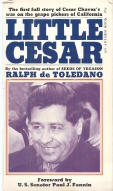May 2014 National Right to Work Newsletter Summary
Go here to read the May 2014 National Right to Work Newsletter and summary.

Go here to read the May 2014 National Right to Work Newsletter and summary.

Professional movie critics overwhelmingly share the rabidly pro-Big Labor politics of the new Hollywood biopic of the much-praised, but little-understood farmworkers union cofounder and comandante Cesar Chavez. But few can bring themselves actually to like Cesar Chavez: History Is Made…

From the Sarasota Herald-Tribune (4/16/1976): A stolen yellow forklift charged through the Jupiter Chemical Co. construction site and ravaged two office trailers like a bull goring a matador. First one and then the other was ripped open. Three men…
An item posted on the AFL-CIO web site yesterday (see the link below) boasts about how Big Labor and its front groups successfully led the charge for passage this week of a New Jersey ballot measure hiking the state’s minimum…
In the 2013 edition of their Union Membership and Earnings Data Book, labor economists Barry Hirsch and David Macpherson report data showing that, from 2002 to 2012, unionized employment in motor-vehicle and motor-vehicle-equipment manufacturing fell from roughly 413,700 to 208,000,…
Surprise, Surprise, President Obama's new NLRB nominees spent their working years at big labor trying to enact the Card Check Forced Unionism Scheme: One of President Barack Obama’s new National Labor Relations Board nominees dedicated her career at the AFL-CIO to doing away with secret ballots in labor elections—a tactic critics say would make it easier to unionize and expose employees to intimidation. Nancy Schiffer spent nearly three decades as a union attorney in a career that took her from Detroit’s United Auto Workers to associate general counsel at the AFL-CIO, a Democratic power broker that spent $30 million on the 2012 election. Schiffer took the lead in many unionization efforts across the country and has spent the past few years trying to do away with the secret ballot in union elections. “[Card check] is needed to address a severe violation of human rights,” she testified to the House Education and Workforce Committee in 2004.
Big Labor is spending $1 million in forced union dues money on TV ads pushing amnesty, according to CNN: As the U.S. Senate prepares for its first procedural votes on the “Gang of Eight” immigration plan, a top labor…

The Wall Street Journal reports that big labor “spends about four times as much on politics and lobbying as generally thought.” Generally thought? …
Union bosses in Indiana are pressing for a judicially imposed bailout, arguing that the state's new Right to Work Law will reduce revenues to the union since membership is no longer compulsory. The LibertyLawSite looks at the lawsuit and the impact the law has had on job creation in the state: Amidst a series of setbacks at both the ballot box and the court house, the fate of the compulsory union movement may depend in large measure on the outcome of two lawsuits currently pending in Indiana. In early 2012, Governor Mitch Daniels signed into law a bill that made Indiana the nation’s twenty-third right-to-work state. Unions have filed two challenges to that law, one each in state and federal court. The outcome of those lawsuits will help to determine whether Indiana remains a right-to-work state and whether other states follow Indiana’s lead. In its first few months of operation, the right-to-work law has, by almost any measure, helped to attract new businesses to Indiana. Indiana has only 2.2 percent of the nation’s population. In April, the first full month after the law took effect, more than one in eight jobs created around the country were created in Indiana – more than in states several times the size of Indiana. According to the state’s economic development arm, almost fifty out-of-state companies cited the right-to-work law as one reason that they were considering opening a location in Indiana.